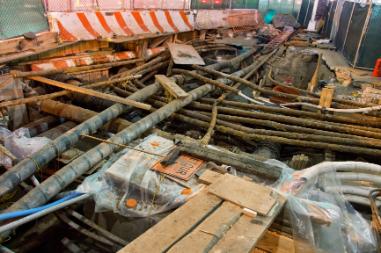Recommendation 2
Housing and ‘hidden infrastructure’, such as efficiency measures, should be considered alongside the large-scale capital investments with which they interconnect, within infrastructure and spatial planning processes.
UK national infrastructure planning, and specifically the National Infrastructure Plan (NIP)[10], gives limited attention to buildings or property and the important social and economic services they provide. Many local infrastructure plans, including those for Newcastle and Gateshead[11] and London[12] recognise the importance of housing efficiency and demand reduction measures. The UK has some of the oldest building stock in the EU, and as much as 80% is expected to still be in use in 2050.[13] The majority of the UK’s housing stock is not particularly energy efficient, and this makes it even harder to address issues of fuel poverty and greenhouse gas emission reductions.
Buildings, and spatial planning more generally, play a critical role in modulating the demands placed upon energy, water and communications networks. Reducing demand for these services through ‘hidden infrastructure’, such as investment in efficiency measures and demand management strategies, reduces consumer bills, frees up capacity to support growth and regeneration, and defers the need for expensive capital investment in new infrastructure (e.g. for new power stations and water treatment works). The National Infrastructure Plan, for example, sets out a pipeline of £65 billion investment in energy generation and £45 billion investment in energy networks over the coming years. Yet, investing a third of this in energy efficiency measures over the next four decades could free up 12% headroom in generation capacity.[14*] These measures are critical to generating long-term and sustainable economic, social and environmental value and must be co-ordinated more effectively.[15*]
The real cost of street works
The UK has a vast network of underground infrastructure assets, with a total length estimated to exceed 4 million km. Regulatory and commercial pressures mean that infrastructure operators are often incentivised to focus on minimising the direct costs at the expense of possible impacts on other utilities and social costs arising from street works. The intensity of co-location of these underground assets often leads to ‘third party damage’ to adjacent buried utilities during street works. Analysis of 3,348 such incidents shows that the average damage repair cost per utility varies across sector: Electricity: £970; Gas: £485; Telecoms: £400; Fibre optic: £2800; Water: £300; Sewer and drainage: £980.[16*] These costs do not take into account wider disruption resulting from loss of service which can be significantly larger. Ongoing research is costing these indirect loses and considering how new business models can better serve the users and infrastructure service providers. |


